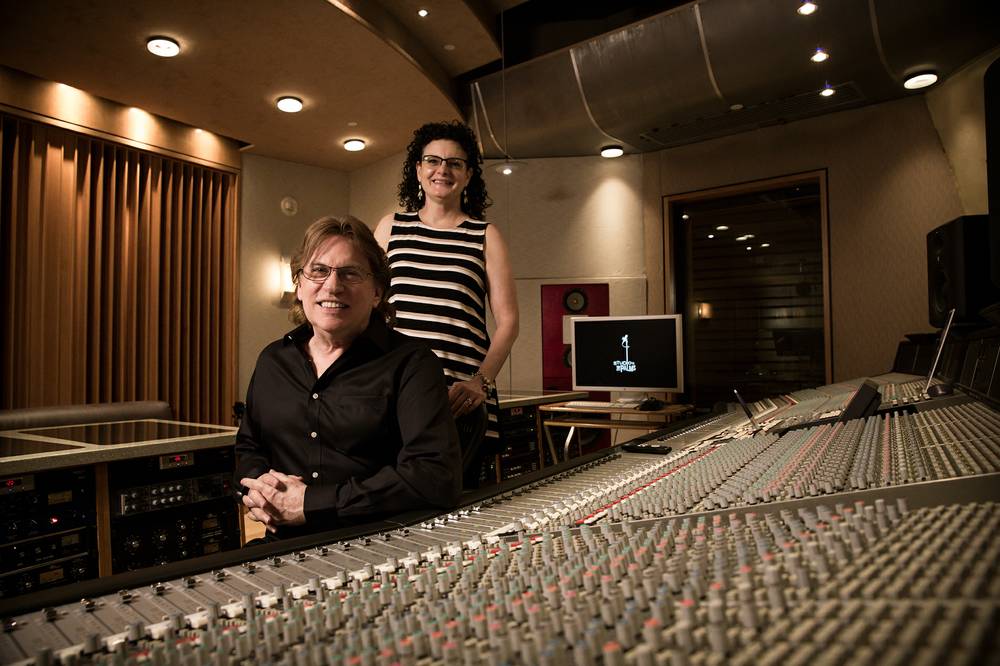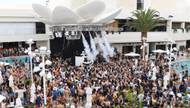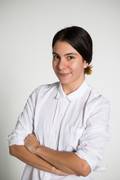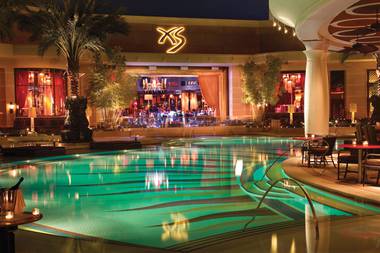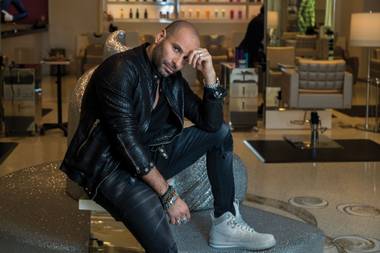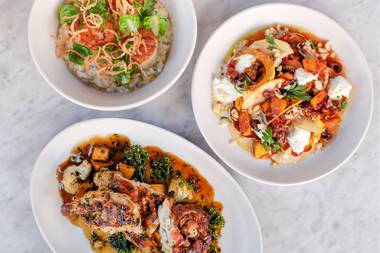Las Vegas hasn’t always been considered a creative hub, but Zoe and Pat Thrall might tell you otherwise.
As the director of the Studio at the Palms, Zoe oversees all the magic that happens inside those soundproofed walls, from sessions with Beyoncé and Lady Gaga to Lil Wayne and more. Her engineer husband, Pat—who has played guitar as part of rock band Asia and on tour with Meatloaf—has worked behind the scenes with pop titans like Britney Spears and The-Dream, and he scored credits on Frank Ocean’s Grammy Award-winning Channel Orange.
What does a typical day at work look like for you?
Zoe Thrall: The process starts on my side. The client calls me and asks for X amount of days in the future to record or mix, and I negotiate the deal and ask what the requirements are as far as equipment and their plans. We anticipate whatever their needs are as much as we can—what the engineers require, the hospitality requirements, the equipment—so once they arrive, all that stuff we know in advance. The day or two before the session I speak closer to the producer and engineer to make sure their exact details are ready, and then I pass the baton the day of the session and that’s when the real work starts.
Pat Thrall: There are different kinds of sessions, so it depends on the kind of music they’re doing. I worked with Tricky [Stewart] and The-Dream, and they produce a lot of huge R&B hits. I was with those guys for almost seven years, and they had a very elaborate setup that was not based on a lot of acoustic instruments. You really have to know what you’re headed into. You can’t just fake your way through. It takes a lot of experience.
How does being a musician yourself help with this job?
Zoe: Those skills you learn being a classically trained musician, those skills apply every single day—just being able to talk the talk. You need to know music.
Pat: Zoe is uniquely qualified for her job, probably like few on the planet, because she’s functioned professionally on all the levels that are required to do this. She started out as an engineer at a famous studio in New York called the Power Station, she played oboe [for Steve Van Zandt] and then after that she moved into the studio management side. So she has experience on all the levels. It’s rare when you’re talking to a studio manager who actually has literal experience in all those aspects. Usually they just know it from being around it, but she’s actually trained in all aspects of it.
You’ve worked with some of the world’s biggest artists. How do you keep things running smoothly?
Zoe: It is the creative process, so once they’re in here and the creative juices are flowing, anything is possible. The best thing we can do is give them their privacy and just create the environment for all that creative juice to come out. It’s my job to make sure that they’re as relaxed as possible.
Is Las Vegas a creative epicenter?
Zoe: Absolutely. Look at the artists that have come out of here, first of all.
Pat: Because studios have been dwindling over the last decade or so, a lot of people that would’ve been studio musicians in Los Angeles 10 or 15 years ago come out here to work on all these shows. There is something about all this, especially if you’re a musician, that has an appeal. There’s really unique stuff that happens here.
How is the Studio at the Palms different from other recording studios?
Pat: With this studio, people were freaked out when we first came here. They were like, ‘This studio is going to be a disaster. Artists are going to come out there and they’re going to be doing too many drugs, and partying, they’re not going to get any work done.” And then what happened? The Killers did their album here, and their producers—Alan Moulder and Flood—they had done U2 and David Bowie and all these huge artists.
They said it was the best thing that ever happened because they didn’t have to leave or go anywhere. Everything was provided here and they got in this bubble. In any other town, you work ‘til 3, 4, 5 in the morning and there’s no place to go. Here, they can just go downstairs, and the bar is open. They get up in the morning, there’d be food right there. They can go to the pool, and you can just take an elevator and go to your room. They said it was one of the best recording experiences they’d ever had. That kind of changed the game here.
Pat, you were a touring guitarist with Meat Loaf in the ‘90s. What made you decide to get behind the boards?
Pat: I always loved it. I had my own band at one point with Glenn Hughes from Deep Purple, and we got to work with this guy named Andy Johns—he was Led Zeppelin’s producer. I learned as much as I could working with those kinds of guys.
By the mid ‘90s I was touring with Meat Loaf for his big comeback, which was amazing, but I reached a point when we got married where—the road, I had my 20-year bachelor party, you know? It was really starting to feel artistically empty. I felt like, okay, it’s great playing live and being a side man, but I needed more, and I wanted to be home with my wife.
At this time, she was running the Power Station … and I came in at a really good time because Pro Tools was just starting to evolve into a usable and functioning recording medium. So I embraced that early and learned it early, and I think had one of the first Pro Tools suites in New York City at the Power Station. So I got to work with a lot of amazing engineers and it just took off from there. And that’s what I’ve been doing ever since.
